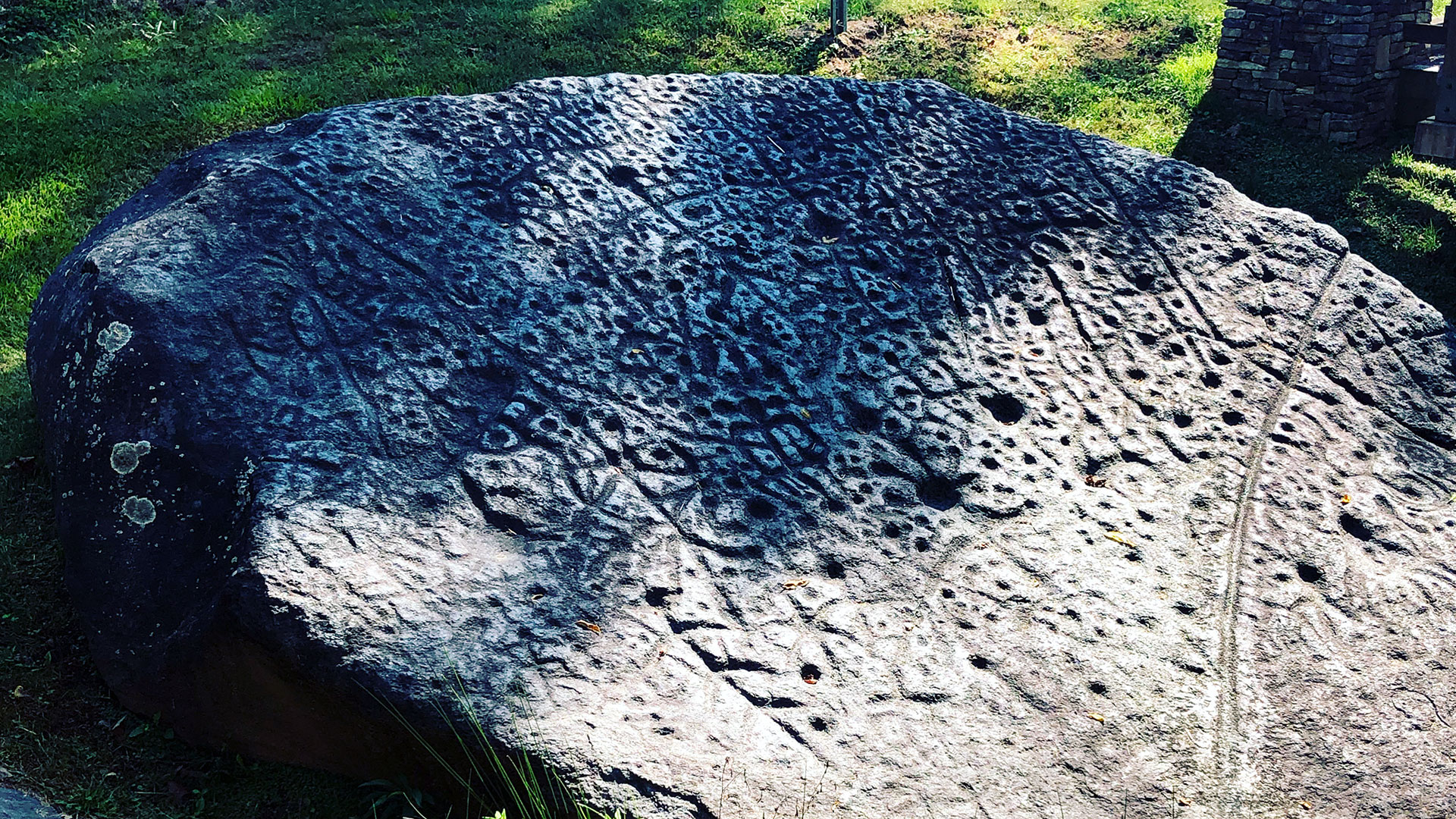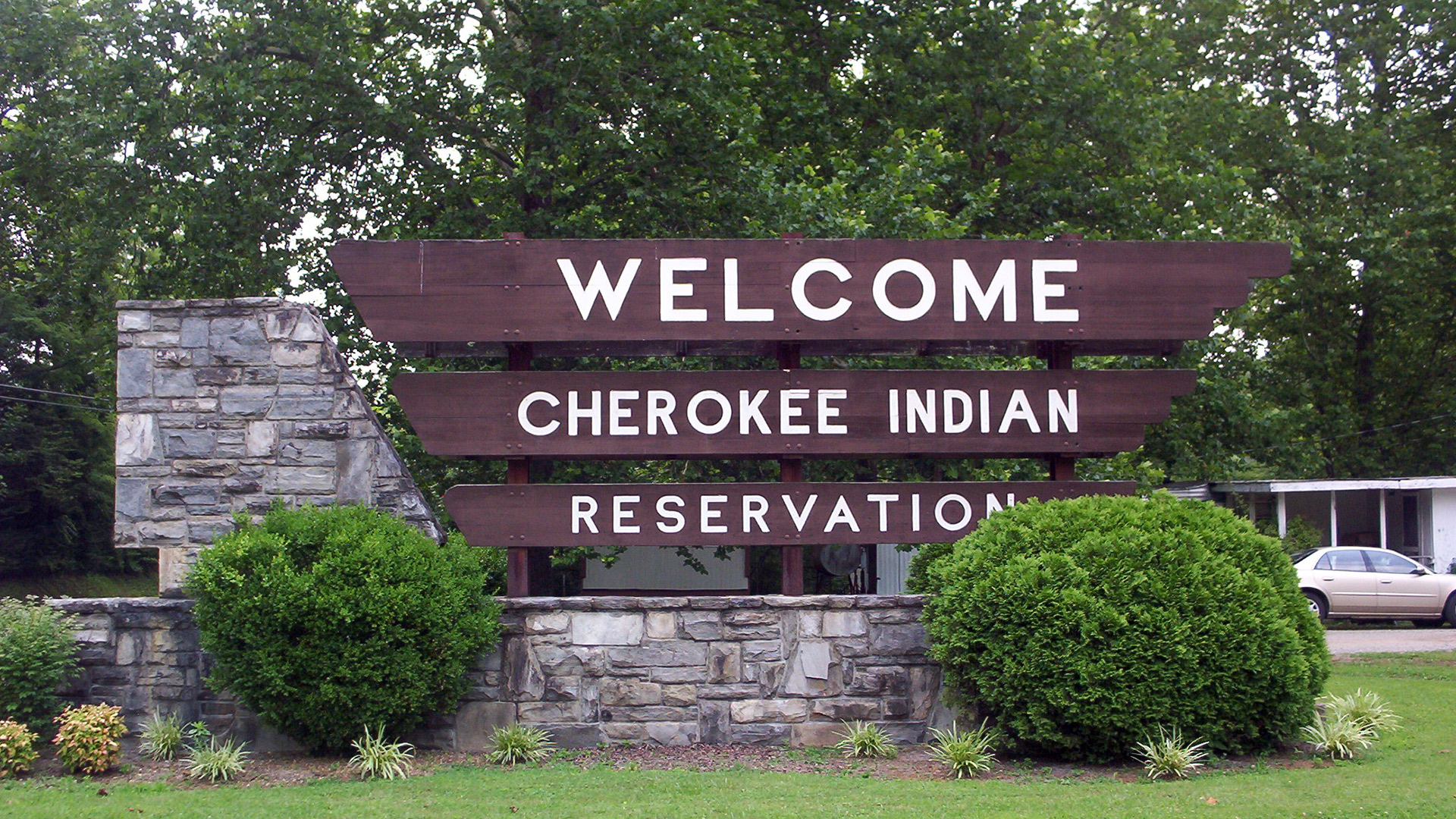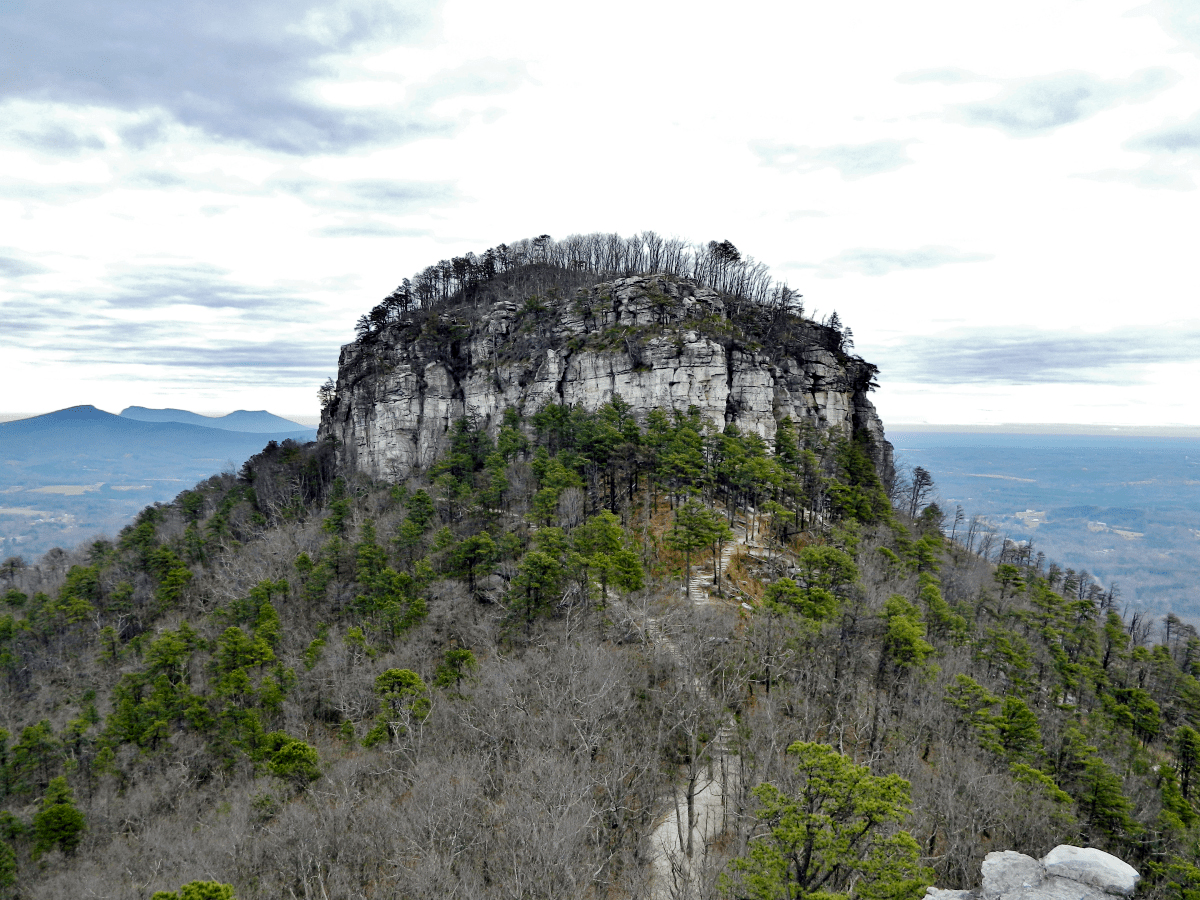
“Where’s the Reservation?”
Tourists come to North Carolina’s Cherokee Country and buy lots of souvenirs. But they rarely connect with the essence of Cherokee culture, which lives in the people’s stories, the geography beneath their feet, and the cosmography above.
There is a certain kind of summer heat that pulses through a souvenir store in Cherokee, North Carolina.
For a cashier, as you stand surrounded by jewelry and knife showcases, a bubbling popcorn machine, and a laminate countertop where you ring up purchases ranging from stone-ground grits to child-sized headdresses in primary colors, the waves of heat wash over you—doors opening and closing, coaxing what is left of the store’s air-conditioned coolness outside to evaporate in the July swelter. It is a stagnate churn that threatens to lull you to sleep as the tourists drone on about prices, seek directions, and scold their children, who chase each other with plastic tomahawks.
It is a heat you desperately want to escape.
I spent my teenage summers behind the counter of my parents’ gift shop, ringing up tomahawks and headdresses for tourists visiting the Qualla Boundary in Cherokee. They would tell me how they had come here as a child and now were bringing their own children, sometimes grandchildren, back to swim in nostalgia. And, in some cases, they would even look me straight in the eye, as I handed them their fresh popcorn, and ask, “Where’s the reservation?” This was the point when the humidity of their breath became suffocating.
I can’t quite blame them, though. The Eastern Band of Cherokee Indians still have a giant wooden sign welcoming visitors to the “Cherokee Indian Reservation” off of Highway 441, even though the Qualla Boundary is not a reservation. It is land we originally inhabited, was stolen, and we bought back. Our culture and community cannot be confined to a government-designated “set-aside” property.

Telling someone they have arrived in the place they are looking for is challenging when the place they are looking for is a mirage. Hollywood-induced misconceptions of an Indian Reservation often rob visitors of the true treasures—our people and this storied landscape, the way we see the earth beneath us and the skies above.
Traditional Cherokee stories are intimately tied to specific places, a topography that stretches along centuries-old footpaths and down clear, cool mountain streams. It expands and contracts across farmland and quaint rural towns—all the while whispering stories of a people too vibrant for nostalgic snapshots. Out beyond the world of craft sales and exhibits and demonstrations lies the vast world of Cherokee culture, which requires no admission ticket and comes with no receipt. It is a world of complex monsters and love stories and other dimensions.
Over the years, I was also asked, many times, “Where are the Indians?” Asking that question on the wrong day to the wrong Cherokee could get you sent in the wrong direction. While I am not completely sure what these inquisitive sightseers pictured, I can safely say they wouldn’t know it if they saw it. And thus, they missed their opportunity.
So, where is the seat of culture for the Eastern Band Cherokee—and indeed all Cherokees? Arguably, it lies, at least in part, in the middle of a tract of farmland just off the Qualla Boundary—Kituwah Mound. The Mothertown.
Over the years, I was asked many times, “Where are the Indians?” Asking that question on the wrong day to the wrong Cherokee could get you sent in the wrong direction.
A family Polaroid by the “Welcome to the Cherokee Indian Reservation” sign or in front of a faux teepee may make a fair keepsake and only require you to tip your photographer, but a visit to Kituwah (site of a mound and village dating back 10,000 years) will show you the roots of this place. Kituwah allows you to understand how all the historic Cherokee villages were situated along waterways, to facilitate trade and the flow of needed resources. It lets you visualize the Council House fire, an early spark of our eternal flame. Cherokee ceremonies, though protected from gawkers, are still alive. The incredibly intricate double-weave rivercane baskets sold in the Qualla Arts and Crafts Mutual Co-Op owe their existence to the canebrakes that flank these villages’ rivers.
The river that borders Kituwah, the Tuckasegee, translates to the “Turtle Place” or “River of Turtles.” Cherokees did not name rivers, but when settlers came, they often named these waterways after Cherokee sites, such as villages. The terrapins on its banks remind of us the Possum and the Terrapin’s story. One day, the pair discovered a tree full of ripe persimmons. After a little teamwork, they began to enjoy a bounty of fruit until a hungry Wolf came along. He intercepted the persimmons that Possum was tossing down to Terrapin. Not to be deterred, Possum threw down a bone instead, choking Wolf to death. Terrapin then made spoons from Wolf’s ears. Terrapin was so proud of the spoons and used them so frequently that the other animals began to believe he had killed Wolf. The Wolves came together, captured Terrapin, and threatened to burn him; however, much like the folklore of Br’er Rabbit, Terrapin convinced them that throwing him into the river would be a far greater punishment. Terrapin survived, but only after cracking his shell on a rock. Resilient, he sang a healing song and mended his shell, but he always wore that reminder of his arrogance on his back.

By following the Tuckaseegee upstream to its confluence with the Oconaluftee River (whose translation is comically disputed and perhaps not appropriate for a mixed audience), one will find the stone that marks the Tuck’s naming. A large boulder, visible only when off the beaten path and best seen in the water, is shaped like a giant terrapin. It reminds us of the millennia-long connections between place and story. A connection that cultivates history.
The Kituwah property reminds me of our first people: Kanati (the Lucky Hunter) and Selu (the Corn Mother). Where are the Indians? the tourists ask. Kanati and Selu are most assuredly the first Cherokee. Though long gone in body, their stories are still tied to place. They were believed to live at or near Pilot Knob or Tsuwateldvyi/Tsuwatelda, a peak of more than 5,000 feet, northeast of Cold Mountain and west of Looking Glass Knob in the Pisgah National Forest. It’s above the headwaters of the Tuckasegee River. The histories of the Lucky Hunter and the Corn Mother are long, and they intersect with several other origin stories, but they all speak of a balanced existence between women and men, both providers for their home and family.
I would entreat visitors—particularly those who appreciate a great love story—to drive just a bit farther from Kituwah toward Bryson City in the spring and visit our neighbors at the family-owned Darnell Farms to pick your own strawberries. The legend of the first strawberry is one of most treasured love stories among the Cherokee people. It tells of a couple on the outs, the woman leaving her partner after yet another disagreement. The man was heartbroken and followed her, grieving all the while; but the woman continued on the path, only looking ahead. The Sun took pity on the man. Sun asked him if he was still cross with his wife or if he would like for her to return. The man confessed that he missed her and wanted her home. Sun devised a plan to slow the woman. He laid down a patch of ripe huckleberries, then sprouted plump blackberries alongside her path; but every time, she passed by without stopping. Undeterred, the Sun cultivated fruit trees and bushes of berries. Nothing slowed the woman. Finally, Sun created something that had never been tasted. Sun laid out a patch of large, red strawberries the woman could not pass by. As she bent to collect them, she turned her face toward the west and the memory of the man overcame her. The more she ate, the more she wished to share the berries with him. As she started back west, she met him on the trail and they returned home together. Their love had been renewed by the sweetness of forgiveness.
Cherokee cosmography dictates that beings exist in the earthly world (a world under the sky arch, where everything lived before the earth was made); the Sky World, which is sometimes likened to a heaven; and an underworld, or Darkening Land.
Some Cherokee stories rooted in place are more complex. One of the most intriguing love stories, in fact, involves a “slant-eyed giant” named Judaculla, the keeper of game at Pilot Knob. Though when he transverses worlds—the world in which humans live and the world in which immortals live—to court a Cherokee woman who became his wife (a term adopted in translation, the legal concept of marriage between a couple appearing only with colonialism) and mother of his children, his story moves to Kanuga on the Pigeon River near Brevard. Different versions of Judaculla’s oral history exist, but most say that Juduculla and his wife disappeared either into a mountain or the sky. Take a short drive to Cullowhee, and you can see Judaculla Rock, whose petroglyph markings, the legend goes, were made by the giant and hold sacred knowledge for anyone who can decipher them. Others believe that Juducalla will one day return and share the knowledge himself.
Cherokee stories are filled with legendary monsters, and Judaculla is one of the kindest. More terrifying are Spearfinger, an elderly woman with a long, pointed finger and fingernail she uses to steal the livers of children, and Uktena, a giant horned serpent said to lurk in the waters of the Tuckasegee, who turns the families of those who cross him into stone.
Uktena was sent away to another realm called Galunlati, but left others like him who hid in the deep pools of rivers. The diamond-shaped crystal imbedded in Uktena’s forehead is a highly prized relic. Anyone who secures it will become the greatest wonder worker of the tribe. This crystal assures success in hunting, love, rainmaking, and every other quest. Its greatest power is the gift of prophecy. Regardless of the potential treasures that await, Uktena promises more futility than you’d like on your summer vacation: only one crystal has ever been acquired and is held in the utmost secrecy.
One need only travel a short distance to Leech Place (Tlanus’yǐ ) in Murphy to test your nerve against the legendary giant red and white striped leech. In this place, Cherokee men supposedly witnessed the water boiling and foaming in the river just as a large spout of water rose up and crashed down before them on the trail. They escaped, but over time, Cherokee bodies would be found along the banks. After a closer look, onlookers noticed that the bodies would be missing their ears and noses. Cherokees stopped crossing the rock bridge traversing the river and avoided the place altogether. So, perhaps this is not the best destination for a curious tourist either.
While these stories indicate worlds that may appear taboo, others tell of far less treacherous but still intriguing Cherokee characters who would mostly likely scoff at the idea of a confined Cherokee Country like a reservation.
Cherokee cosmography dictates that beings exist in the earthly world (a world under the sky arch, where everything lived before the earth was made); the Sky World, which is sometimes likened to a heaven; and an underworld, or Darkening Land. However, it is important to note that this upperworld and underworld do not represent a duality like the Christian heaven and hell. They are not symbols of good and evil. Additionally, the physical world in which you and I live is not separate from the spiritual worlds.
The average Qualla Boundary visitor grabbing lunch at the downtown Burger King or walking their dog near the Great Smoky Mountains National Park entrance is likely unaware of how close they stand to the Nunehi—the immortals.
These fairy-like beings traverse the depths of rivers, the heights of the Bald Mountains and everywhere in between. They are most significantly connected with Nikwasi Mound (Star Place) near Franklin. This connection suggests that they have a link to the Sky World. No qui si pronounced nokw-she or gnaw-qu she, means star in the Cherokee language. Away from the hustle of busy streets, the Nunehi can sometimes be heard drumming and singing at sites such as Nikwasi. Historically, they are credited with warning the Cherokee of invaders and also serving as warriors alongside them. It is believed that they live deep within the earth, where they can also access the underworld.
Far more information, offered completely free, comes from these Cherokee narratives of place. The places themselves can heal. But to touch that power requires an understanding of the culture, its language, and scientific complexity of flora and fauna to truly find a balance, a “to-hi.” This isn’t in the brochures.
Sometimes, more adventurous tourists come to Cherokee seeking healing—even directly asking for a medicine person or shaman. In all honesty, I know more non-Natives who have connected with shamans than I do Cherokees. The practice described by non-Native people is typically not one that resonates with Cherokees. For visitors, I imagine someone was simply willing to take their money and prescribe a “sweat” or a tincture or a tea.
If a newcomer seeks healing, they need not look for such magic. Far more information, offered completely free, comes from these Cherokee narratives of place. The places themselves can heal. But to touch that power requires an understanding of the culture, its language, and scientific complexity of flora and fauna to truly find a balance, a “to-hi.” This isn’t in the brochures.
The Cherokee “origin of disease” story gives us some insight into this approach. The oral history states: all the creatures on Cherokee land met in different locations to discuss and devise their approaches to disease and healing. For example, the bears met at Kuwohi—Mulberry Place (inaccurately named Clingman’s Dome), flying insects came together at Bumble Bee Place near Cheoah Bald, the deer gathered at Gregory Bald, and the reptiles and amphibians hatched their plans at Lizard Place near Tatham Gap. The animals were understandably not pleased with how the humans had disregarded them or treated them poorly, so they concocted an assortment of diseases to slow the growth of the human population. But one creature, because he was too small to eat, spoke on behalf of men: the chipmunk. His defense of humans angered the animals, and they attacked the chipmunk. The stripes on his back are his scars. Luckily for humans, we had other allies—the plants. The plants met every disease with a cure, and we can find these cures all over Cherokee Country.
It is a difference in traveler's world view, I suppose. Most tourists coming through Cherokee Country believe it is a confined GPS location on a map. By the way, GPS does not work well in Cherokee, and this fact amuses me and perhaps supports my thesis. In addition to adding another red-tipped pin to a U.S. map, visitors often want to take a piece of their vacation home. They want to purchase a piece of culture. And yes, we are happy to sell it to them. But the truth is, they’ve overpaid and been underserved. No tomahawk or headdress comes with a story. No walk along a downtown sidewalk heals the soul. We’ve reserved the best of this so-called “reservation” far beyond the Boundary lines. We’ve marked it not with road signs and U.S. Department of Interior benchmarks. We’ve marked it with timeless narrative histories that continue to direct us between worlds—no reservations required.
About the author
Annette Saunooke Clapsaddle, an enrolled citizen of the Eastern Band of Cherokee Indians, lives in Qualla, North Carolina, with her husband, Evan, and sons Ross and Charlie. She holds degrees from Yale University and the College of William and Mary. Her debut novel, Even As We Breathe, was released by the University Press of Kentucky in 2020, was a finalist for the Weatherford Award and named one of NPR’s Best Books of 2020. In 2021, it received the Thomas Wolfe Memorial Literary Award. Her first novel manuscript, Going to Water,is winner of the Morning Star Award for Creative Writing from the Native American Literature Symposium (2012) and a finalist for the PEN/Bellwether Prize for Socially Engaged Fiction (2014). Clapsaddle’s work has appeared in Yes! Magazine, Lit Hub, Smoky Mountain Living Magazine, South Writ Large, Our State Magazine, and The Atlantic. In 2023, in partnership with Museum of the Cherokee Indian, Clapsaddle launched Confluence: An Indigenous Writers’ Workshop Series that seeks to bring indigenous writers to the Qualla Boundary to work with aspiring writers several times throughout the year.


